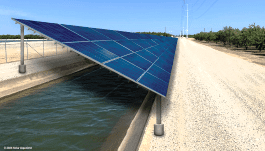Pilot to study solar covers for irrigation canals sheds light on future solutions
August 20, 2024

AWWA Articles
Pilot to study solar covers for irrigation canals sheds light on future solutions
One of the first canal-based solar projects in the country is being constructed in California’s Central Valley to study the innovative concept’s ability to save water and energy.
 Turlock Irrigation District (TID), which provides irrigation water and electricity to more than 240,000 residents in the region, is a partner in Project Nexus, along with the California Department of Water Resources, the University of California at Merced (UC Merced), and development firm Solar AquaGrid.
Turlock Irrigation District (TID), which provides irrigation water and electricity to more than 240,000 residents in the region, is a partner in Project Nexus, along with the California Department of Water Resources, the University of California at Merced (UC Merced), and development firm Solar AquaGrid.
The project involves the installation of solar panel canopies over sections of TID’s irrigation canals to protect water resources and generate more than one megawatt of renewable electricity. More information is available in this video.(Pictured right, an image of a solar power canopy being installed over some Turlock Irrigation District canals in California.)
A 2021 UC Merced study demonstrated that covering California’s approximately 4,000 miles of public water delivery system infrastructure with solar panels could result in significant water, energy and cost savings. This includes an estimated savings of 63 billion gallons of water annually by reducing evaporation, and potential generation of 13 gigawatts of renewable power.
 “It’s difficult to say ‘yes’ to new, different projects that are full of unknowns, but we’re so glad we said yes to Project Nexus,” said Brad Koehn, TID’s general manager. “This project, and innovative solutions like it, are needed to meet the challenges that are ahead for TID and our customers.”
“It’s difficult to say ‘yes’ to new, different projects that are full of unknowns, but we’re so glad we said yes to Project Nexus,” said Brad Koehn, TID’s general manager. “This project, and innovative solutions like it, are needed to meet the challenges that are ahead for TID and our customers.”
To provide a test model to further study this concept, solar panel canopies are being installed at two TID locations – one at a 20-foot-wide location and another at a 110-foot-wide site. Construction is expected to be complete and commissioned in 2025 and UC Merced is collecting research data at both sites.
In addition to advancing water conservation and renewable energy, other potential benefits that Project Nexus will be studying include:
- The ability of canal water to cool the solar panels and increase their efficiency
- The possibility that the shade and wind protection from solar panels may also reduce the growth of algae and aquatic weeds, leading to reduced water treatment and canal maintenance costs
- The prospect of adding energy storage capabilities
- The environmental advantages of locating solar panels over canals rather than on land
“Project Nexus was named as a nod to the water-energy nexus paradigm that is popular among public utilities,” said Bill Penney, TID senior civil engineer and Project Nexus project manager. “The project combines those two things that are at the very core of what TID does – water and power.”
Advertisement